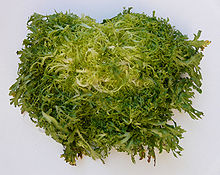- Endive
-
Endive 
Escarole endive Scientific classification Kingdom: Plantae (unranked): Angiosperms (unranked): Eudicots (unranked): Asterids Order: Asterales Family: Asteraceae Genus: Cichorium Species: C. endivia Binomial name Cichorium endivia
L.Endive (
 /ˈɛndɪv/[1] or /ˈɛndaɪv/), Cichorium endivia, is a leaf vegetable belonging to the daisy family. Endive can be cooked or used raw in salads.
/ˈɛndɪv/[1] or /ˈɛndaɪv/), Cichorium endivia, is a leaf vegetable belonging to the daisy family. Endive can be cooked or used raw in salads.Contents
Background
Endive is also a common name for some types of chicory (Cichorium intybus). There is considerable confusion between Cichorium endivia and Cichorium intybus.[2][3]
Endive belongs to the chicory genus, which includes several similar bitter leafed vegetables. Species include endive (Cichorium endivia), Cichorium pumilum and common chicory (Cichorium intybus). Common chicory includes chicory types such as radicchio, puntarelle and Belgian endive.
Endive is rich in many vitamins and minerals, especially in folate and vitamins A and K, and is high in fiber.
There are two main varieties of cultivated endive:
- Curly endive, or frisée (var crispum). This type has narrow, green, curly outer leaves. It is sometimes called chicory in the United States and is called chicorée frisée in French. Further confusion results from the fact that frisée also refers to a technique in which greens are lightly wilted with oil.
- Escarole, or broad-leaved endive (var latifolia) has broad, pale green leaves and is less bitter than the other varieties. Varieties or names include broad-leaved endive, Bavarian endive, Batavian endive, grumolo, scarola, and scarole. It is eaten like other greens, sauteed, chopped into soups and stews, or as part of a green salad.
See also
- Chicory
References
External links
- Belgian Endive Official Resource Page for Belgian Endive
- Endive and Chicory
- Frisée
 "Endive". Collier's New Encyclopedia. 1921.
"Endive". Collier's New Encyclopedia. 1921.
Categories:- Leaf vegetables
- Cichorioideae
- Belgian cuisine
Wikimedia Foundation. 2010.

